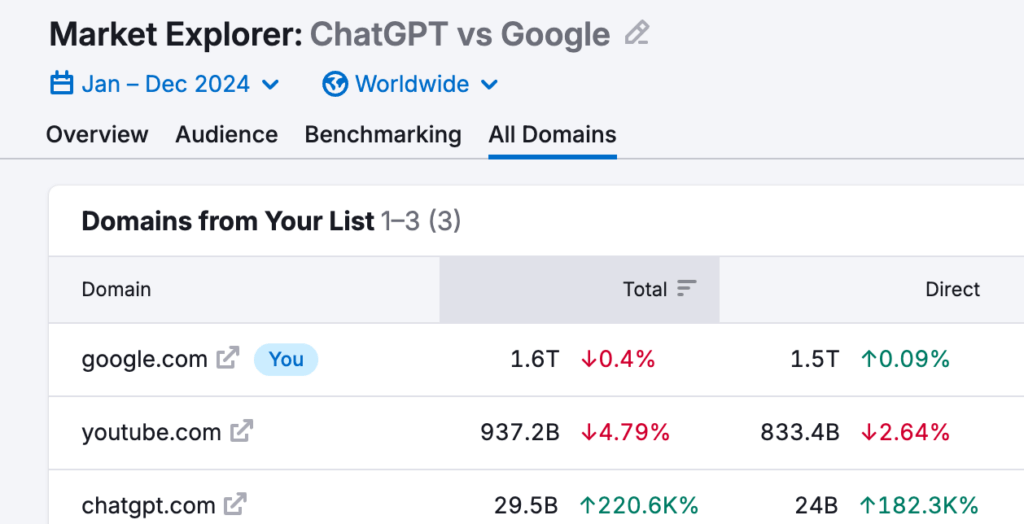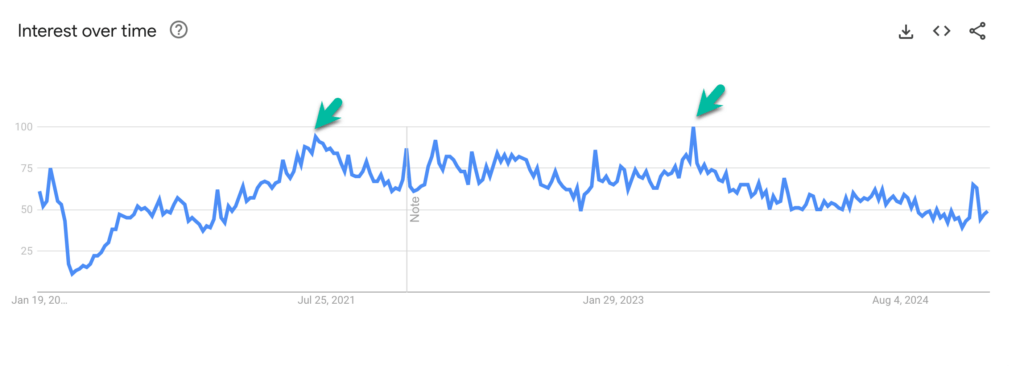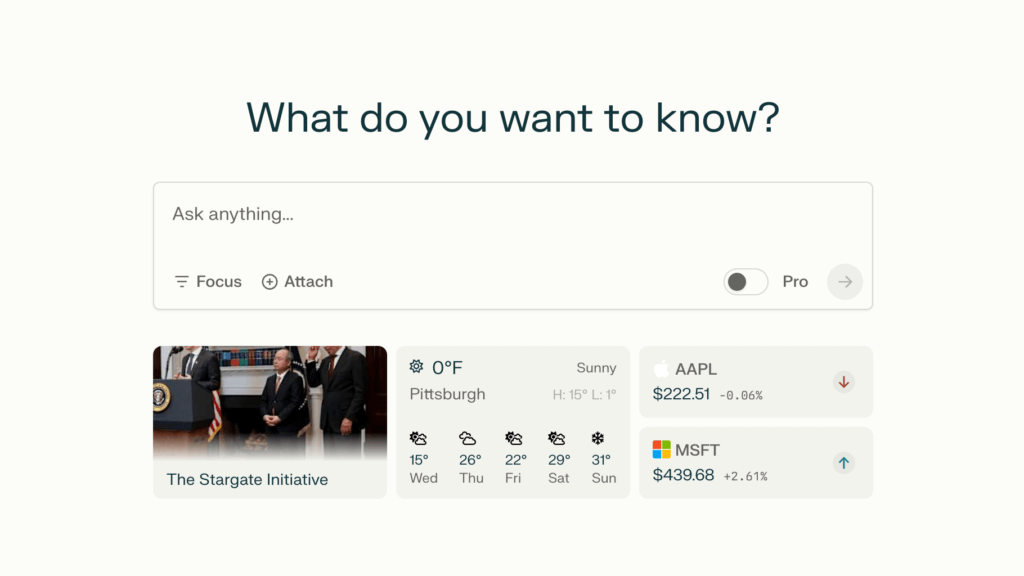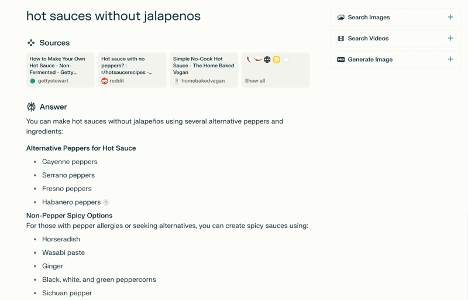
ChatGPT’s Search Capabilities in 2025: Can It Rival Google?
Can conversational AI disrupt Google’s search engine supremacy?
While ChatGPT has gained significant momentum with its conversational interface and advanced AI capabilities, these very strengths may pose challenges in adapting search users to its platform. Let’s explore the hurdles AI platforms face as they strive to compete with Google’s entrenched search engine supremacy.
Google vs. ChatGPT — Assessing Market Share and Trends
How can the future of search competition be understood without first examining the past?
To evaluate the competition between Google and ChatGPT in the search market, SEMRush’s Market Explorer tool was used to analyze direct traffic over the past six months. YouTube was included under Google, as its search functionalities align with Google’s broader ecosystem. Direct traffic was chosen as the primary metric because it reflects brand recognition, habitual use, and user intent — key indicators of platform loyalty.
Market Share (July-December 2024):
- Google.com: 777.2 billion visits (74.6%)
- YouTube.com: 395.4 billion visits (23.9%)
- ChatGTP.com: 19.7 billion visits (1.5%)
At first glance, ChatGPT’s share appears negligible. However, its rapid growth over the past year is striking. Between January and July 2024, ChatGPT’s direct traffic surged by an extraordinary 182K%, signaling increased user interest and adoption. In contrast, Google and YouTube showed more modest or stagnant growth trends during the same period.

This data highlights ChatGPT’s rise while underscoring the significant gap it must close to challenge Google’s entrenched dominance.
Beyond Search: The Murky Waters of ChatGPT’s Influence
Not all ChatGPT usage directly overlaps with Google search. For example, users may upload a spreadsheet and request ChatGPT to analyze trends. While this interaction is not a traditional search, it could potentially replace multiple Google searches on how to filter or analyze data.
This raises an important consideration: could exposure to ChatGPT’s broader capabilities create a comfort level that encourages its use for unrelated queries, including searches? While this hypothesis makes sense, concrete data is not yet available to answer definitively.
ChatGPT’s Search Capabilities in 2025: A Viable Alternative to Google?
While ChatGPT was not originally designed as a search engine, its evolving AI capabilities are shaping how users find and interact with information online. As of 2025, ChatGPT has integrated a range of AI-powered search features aimed at improving response accuracy, personalization, and real-time knowledge retrieval.
So, how does ChatGPT’s search compare to Google?
Conversational Search vs. Keyword-Based Queries
Unlike Google, which thrives on fragmented keyword searches (e.g., “best sushi NYC”), ChatGPT encourages users to phrase queries more naturally (e.g., “Where can I find the best sushi in NYC with outdoor seating?”). This shift in behavior has created an alternative search experience that some users prefer—especially for research-heavy, complex, or personalized queries.
Integrated Real-Time Search (But With Limits)
A major limitation in early versions of ChatGPT was its knowledge cut-off date, preventing it from providing up-to-date information. However, recent integrations—including OpenAI’s SearchGPT—have allowed ChatGPT to fetch live data, bridging the gap between static AI models and real-time search. While it doesn’t yet match Google’s extensive web indexing, OpenAI’s partnerships with external databases indicate an effort to improve real-time retrieval.
AI-Powered Personalization & Context Retention
Unlike Google’s traditional search, which serves results based on page rankings and ad placements, ChatGPT processes queries by understanding user intent, context, and previous interactions within the same conversation. This creates a more personalized search experience, allowing users to refine results dynamically instead of starting a search from scratch.
The Cost Barrier: Can AI Search Scale?
Despite these advancements, one of the biggest challenges facing ChatGPT as a Google alternative is scalability. AI-powered searches require significantly more computing power than a simple Google search query. In 2024 alone, OpenAI incurred $5 billion in losses due to the high operational costs of running ChatGPT’s conversational AI. This raises a critical question: Can AI-driven search platforms become a sustainable, mass-market alternative to Google?
Market Share & Adoption: A Slow Climb
While ChatGPT has gained traction, Google remains the dominant force in search. As of late 2024:
- Google Search: 74.6% of all search traffic
- YouTube Search (Google-Owned): 23.9%
- ChatGPT: Only 1.5% of total search traffic
Even with a 182,000% growth in direct traffic, ChatGPT still faces a massive uphill battle in challenging Google’s deeply ingrained user habits and ad-driven revenue model.
The Gap Between ChatGPT and Common Search Habits
AI has been heralded as a catalyst for a more conversational approach to search — or at least, that has been the prevailing theory.
In reality, most search queries remain simple, fragmented and not constructed in full sentences. Consider the example below, which demonstrates a typical search habit:
“Hot sauce no jalapeno”
This phrasing reflects how search engines like Google have conditioned users to communicate. Compare this to how one might naturally phrase the same request to a friend:
“I’m looking for a hot sauce that doesn’t use jalapenos because I’m allergic to them.”
The assumption was that conversational AI would disrupt such habits, ushering in a “great reckoning” for traditional search behaviors. Yet this shift has not occurred as anticipated — at least not in the way many envisioned.
Google’s Strength in Simple Queries
Google’s algorithm has long trained users to rely on concise, fragmented queries. Phrases like “cheap flight NYC London” effectively convey intent without requiring full sentences. This efficiency has made Google an indispensable tool for quick searches.
Efficiency vs. Engagement
Here lies the trade-off: ChatGPT is designed as a conversational platform that prioritizes engagement. However, engagement isn’t always what users want during a search.
When ChatGPT first captured public attention and mass user adoption began, it was assumed Google’s dominance might be in jeopardy. Yet, Google’s traffic actually increased between May 2023 and May 2024, highlighting an important insight: conversational AI platforms, such as ChatGPT, are not poised to replace Google as easily as some expected. Marketers weren’t reading the room, as they say.
ChatGPT’s design embraces human-like interactions, which contrasts sharply with traditional search behavior. This fundamental difference explains why Google continues to thrive. Users generally do not perceive ChatGPT as a rapid-fire search mechanism for everyday queries.
A Tale of Two Queries: Simplicity vs. Conversation
Consider the stark contrast between a traditional search query and a conversational one:
- Traditional search: “Best restaurants near me”
- ChatGPT-style query: “Can you Can you recommend some great restaurants near me with outdoor seating and live music? I’m planning a date night.”
The former is direct and concise, while the latter prioritizes personalization and context. Google excels at serving the former, which represents the majority of search habits.
Trends Unchanged by ChatGPT
Google Trends data further illustrates this. The screenshot below, taken in January 2025, displays a normal fluctuation in search activity for restaurant-related queries. The green arrows mark seasonal peaks, such as the summer months of July. This data suggests that user behavior has remained consistent, even in the face of ChatGPT’s growing popularity.

Most users continue to default to simplicity, even as conversational tools become more available. Decades of Google shaping user expectations around concise inputs and accurate results have left a lasting impact — one that conversational AI has yet to overcome.
Financial and Political Woes
In early 2023, then-President Biden tested ChatGPT and publicly expressed his admiration for its capabilities. During this interaction, he asked it to write a legal brief for a Supreme Court case and compose a rock song — demonstrations that both impressed and raised concerns.
This event spurred Biden to sign an executive order on AI safety, aimed at addressing the economic impact of AI systems, including their high energy consumption and operational costs.
In contrast, President Trump, upon his election, announced a $500 billion AI investment plan prominently featuring OpenAI’s founder, Sam Altman.
Despite contrasting approaches, one issue remains constant: the high cost of running AI systems continues to be a significant barrier to widespread adoption, particularly for smaller businesses and governments. Unlike Google’s search platform — which grew largely free from regulatory friction during its early years — AI platforms must navigate a more complex political landscape globally during their infancy.
Why Does This Matter?
The same conversational and interactive features that make AI an impressive tool also hinder its scalability due to high operational costs. Nearly all AI platforms offer upgraded, paid plans, but even these may not suffice to offset expenses.
For instance, ChatGPT’s current pro plan, priced at $200 per month, failed to break even in 2024, with OpenAI incurring a staggering $5 billion in losses. This highlights a central challenge: Can AI platforms afford to offer free services to attract mass adoption, especially for the basic, everyday queries that dominate search habits?
Consider this: users are accustomed to searching for “hot dog shops near me” without paying a dime. If platforms like ChatGPT cannot entice users with free or low-cost options for such queries, they risk remaining a niche tool rather than a widely adopted alternative.
Leaving this issue to government intervention is unlikely to provide a quick resolution. Regardless of political alignment, major initiatives take years to materialize, further delaying AI’s path to mass adoption.
This raises an inevitable question: why doesn’t ChatGPT simply provide search results in the same way Google does?
Integrating Simplistic Search Mechanism Into AI Platforms
Not everyone enjoys typing out conversational and thoughtful queries when searching for something as straightforward as “hot sauce that doesn’t trigger allergies.” Similarly, it may be prohibitively expensive for AI platforms to process complex queries for something as simple as listing “10 non-jalapeno hot sauces.”
So, why not integrate the simple keyword search foundations that users are accustomed to into AI platforms?
Well, this is already happening, though without as much fanfare (depending on who you ask).
Last year, OpenAI announced SearchGPT, a product that utilizes the familiar ChatGPT interface while delivering results that resemble Google’s search engine results pages (SERPs). Before this, Perplexity, a self-proclaimed free AI-powered answer engine, gained traction for attempting to blend conversational and traditional search.


Perplexity’s interface combines elements of conversational AI with the simplicity of traditional search. Officially launched in August 2022, it fully rolled out in January 2023 as the “ask engine” demonstrated above.
Using SEMRush, we can estimate its traffic trends:

Perplexity currently garners an estimated 750K clicks per month. While that figure might sound promising, it is minimal in the broader search landscape.
For comparison:
- ChatGTP: Estimated 5M monthly searches
- Google: Estimated 531M monthly searches

Recognizing the challenge, OpenAI became self-aware (pun intended) of the situation and aggressively pursued its own hybrid product, SearchGPT. However, this too has struggled to gain traction.
Optimize for Featured Snippets & Clickability
With ChatGPT gaining traction as an alternative search tool, users are beginning to compare its AI-powered search to Google’s traditional keyword-based system. However, their core functionalities remain distinct.
To make this comparison clearer, let’s break down the key differences between Google and ChatGPT’s search capabilities in 2025:
Google vs. ChatGPT: How Their Search Capabilities Compare
| Feature | Google Search | ChatGPT Search |
| Query Style | Keywords-based | Conversational |
| Personalization | Limited (Based on cookies, history) | AI-Driven, remembers context within sessions |
| Real-time Data | Yes (Constantly updated) | Limited (Depends on integrations & model training) |
| Market Share (2025) | 74.60% | 1.50% |
| Ad Revenue Model | Dominant (Ad-driven results) | No ads, focuses on AI-generated responses |
| Indexing | Billions of pages indexed daily | Limited (Relies on AI training data & selective browsing) |
| Response Format | Search results & links | Conversational answers & summaries |
How This Impacts Search Behavior
- Users Seeking Fast, Direct Answers: Google remains the go-to for quick searches like “cheap flights NYC to London.”
- Users Needing Personalized, In-Depth Responses: ChatGPT’s conversational AI is more suited for complex questions like “Can you explain the best way to book a cheap flight with layovers?”
- Google Remains Essential for Real-Time Updates like breaking news, stock prices, and live sports scores—whereas ChatGPT’s knowledge depends on integrations and periodic updates.
Why This Matters for Marketers
- SEO strategies must balance traditional search optimization (Google) with AI-optimized content for platforms like ChatGPT.
- Content designed for featured snippets (clear, structured answers) has a higher chance of ranking in Google AND being used in AI-generated summaries.
- Brands should experiment with AI-friendly formats, such as FAQ pages, conversational-style content, and structured data, to improve visibility across both search engines and AI-driven platforms.
The Bigger Issue: Becoming Just Another Search Engine
As AI platforms adopt simpler search mechanisms, they risk losing their unique value. By reducing interactive, collaborative and human-like features to mimic Google, they begin to resemble yet another search engine. This presents a critical challenge: becoming indistinguishable from traditional competitors in a space already dominated by Google.
A long list of search engines have tried and failed to rival Google, even with unique features:
- Bing: The most successful competitor, yet still a distant second.
- Yahoo: Once the go-to search engine, outsourced its technology to Microsoft Bing in 2009.
- DuckDuckGo: Marketed as a privacy-focused alternative, yet holds less than 1% market share.
- Ask Jeeves: Launched in 1996 with a conversational approach but couldn’t match Google’s scalability.
- Baidu: Dominates China but has little influence outside its borders.
Despite their differing efforts — privacy, sustainability or regional focus — none managed to dethrone Google’s relevance, speed or ecosystem integration.
Why Conversational AI Must Stand Apart
This leaves AI platforms with a strategic challenge. To avoid becoming just another Google, they must focus on selling the conversational experience, rather than mimicking simplistic search models. However, as explored earlier, this strategy comes with its own set of hurdles:
- Cost: Offering high-quality, interactive experiences remains expensive.
- Politics: Government regulations and initiatives add complexity to AI adoption.
- User Habits: Decades of Google use has entrenched simple, keyword-based search behaviors.
To carve out a meaningful share of the search landscape, AI platforms must innovate in ways that differentiate them from Google, rather than emulate it.
What This Means for Marketers and Brands
The rise of AI-driven search alongside Google’s dominance signals a shift in how users discover content. Marketers must balance traditional SEO with AI-friendly strategies to stay visible.
Adapt Content for AI & Google:
Conversational AI favors natural, human-like language. Optimizing content for both AI-driven queries and Google remains crucial. Blog posts, FAQs, and structured data can enhance visibility across platforms.
Leverage Bold Storytelling:
Authentic, unconventional messaging helps brands stand out. For example, 19 Crimes’ partnership with UFC disrupted traditional beverage marketing, proving that creative narratives engage audiences and challenge norms.
Invest in Engaging Formats:
User attention is fragmented across search engines and AI tools. High-quality videos, infographics and interactive media help capture interest. The 9Rooftops Wild Wonders campaign for South Carolina tourism exemplifies how immersive visuals foster authentic connections. Additionally, you can pair high-quality, engaging content formats with email marketing strategies to nurture leads and build deeper relationships with audiences.
Prioritize Trust & Authority:
Users gravitate toward reliable sources. Upholding E-A-T principles (Expertise, Authoritativeness, and Trustworthiness) strengthens content performance across AI and traditional search platforms. By balancing AI-driven engagement with proven SEO strategies, brands can navigate this evolving digital landscape and maintain relevance.
This is not an advertisement, and solely reflects the views and opinions of the author. This website and its commentaries are not designed to provide legal or other advice and you should not take, or refrain from taking, action based on its content. Additionally, unless otherwise stated, neither 9Rooftops nor the author is involved in, or responsible for, the marketing or promotional efforts of the individuals or entities discussed.

